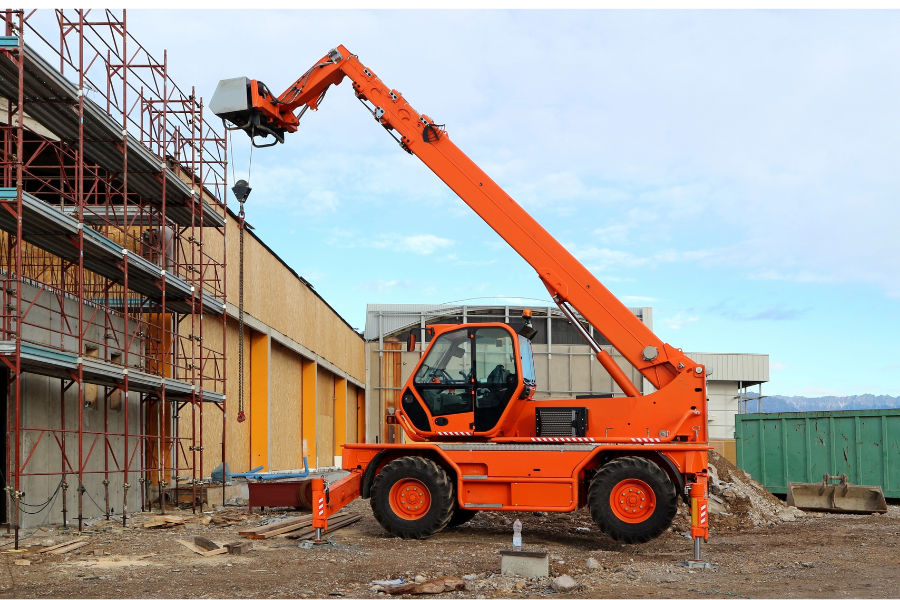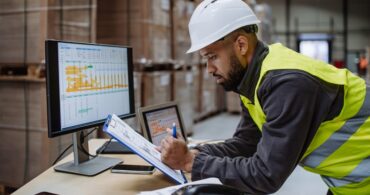Telehandlers are often described as a combination of a crane and a forklift. They may be kind of funny-looking, but telehandlers are serious machines when it comes to versatility and efficiency.
What is telehandler?
Is it a forklift? Is it a crane? All of the above.
A telehandler, also known as a telescopic forklift (and sometimes, colloquially, “teller handler”), is a highly versatile piece of construction equipment. It features a cab that kind of looks like half of a dune buggy (cut down the middle) plopped on top of an industrial vehicle. It typically utilizes pneumatic tires designed for rugged terrain. However, the most prominent feature is its telescoping arm, or boom, that’s attached to the vehicle’s rear.
The boom is the reason for the telehandler’s unusual, half-dune buggy appearance. Because when it’s not in use, the boom rests beside the cab along the length of the vehicle.
Telehandler lift capacity
A telehandler’s ability to reach heights and distances that are impossible for most other machines makes it irreplaceable on many job sites.
Height and reach
The extendable boom of a telehandler allows it to lift materials to impressive heights. However, the telescopic boom does more than simply travel up and down. It can also move left and right; tilt forward, backward and side-to-side; and extend typically as much as 30 feet (some models go further) and up to a 70-degree angle.
Heavy Lifting
Telehandlers are designed to lift large, bulky materials that would be difficult or impossible to move manually. The telehandler lift capacity ranges from a few thousand pounds for compact models to over 20,000 pounds for high-capacity models.
Telehandler sizes
Telehandlers come in various sizes to accommodate different needs and applications. The range of sizes allows users to select the telehandler that best fits their needs.
Compact telehandlers
A smaller telehandler machine is designed for tasks that require high maneuverability in tight spaces. They are ideal for indoor material handling, construction sites with limited space and agricultural operations in confined areas. Compact telehandlers are also easier to transport between job sites than larger models.
However, even though they are smaller, compact telehandlers are still powerful machines. For example, the smallest cat telehandler (Caterpillar is a popular manufacturer of construction equipment) can still lift around 5,500 pounds and has a maximum lift height of approximately 18 feet.
Mid-sized telehandlers
Mid-sized telehandlers deliver a balance between reach, lift capacity and maneuverability. Generally, mid-sized telehandlers have lower fuel consumption and maintenance costs compared to larger models. This makes them a more economical choice for businesses looking to manage expenses.
Large (high-capacity) telehandlers
Designed for heavy-duty tasks, large telehandlers can reach further and lift higher than their smaller brethren. These beasts can lift loads that sometimes exceed 20,000 pounds and have a boom that can extend upwards of 50 feet. You often see large telehandlers roaming large-scale construction and infrastructure projects.
Telehandler construction
Telehandlers are built to be durable, stable and, perhaps most important, safe.
Frame
Telehandlers have strong, durable frames that can withstand the rigors of heavy lifting and rough terrain. The frame is typically made of high-strength steel.
Engine
Telehandlers are equipped with powerful engines that help the truck navigate rough terrain. In addition, the telescopic boom of a telehandler requires substantial power to move heavy loads to remarkable heights and distances. Speaking of…
Telescopic boom
The telehandler’s boom allows the machine to place cargo in areas that would be impossible for most industrial trucks to reach. The boom is usually constructed from the same high-strength steel as the frame, which is why it can extend and retract smoothly while moving very heavy loads.
Steering
Telehandlers typically have multiple steering options, so operators can choose the one that best helps them navigate their specific terrain.
- Front-wheel drive: only the front wheels steer the vehicle.
- Four-wheel drive: provides maneuverability that enables the machine to handle bumps and make quick turns.
- Circle steering: front and rear wheels move in opposite directions (for a tight turning radius).
- Crab steering: all wheels rotate in the same direction, so the vehicle can move diagonally.
To control a telehandler machine, an operator uses sensors to monitor the load. These sensors also warn an operator when the vehicle has exceeded its lifting capabilities and will cut off the controls when it senses an unsafe situation to help prevent accidents.
Stabilizers (outriggers)
To ensure stability when lifting heavy loads, many telehandlers are equipped with hydraulic front stabilizing legs, known as outriggers. These components provide support that prevents movement, provides additional balance and helps keep the machine from tipping over.
Attachments
While most telehandlers move cargo with pallet forks, there are attachments that help the telehandler perform different jobs, such as:
- Jibs to operate like a crane.
- Buckets to scoop dirt and other material.
- Plows to remove snow and other debris.
- Cages to raise workers to higher elevations.
Telehandler uses
One of the most significant advantages of telehandlers is their ability to perform a wide range of tasks for a variety of industries.
Construction
Telehandlers are widely used on construction sites. Their extendable boom allows them to move heavy loads—such as pallets of construction supplies, bricks and steel beams—and place these at heights reaching several stories.
Agriculture
In agricultural settings, telehandlers are used to handle bales of hay and move feed. They can also be used for loading and unloading equipment and supplies, as well as for general maintenance tasks around the farm.
Warehousing and distribution
Most telehandlers are too large for warehouse operations. However, the maneuverability of some smaller machines makes them effective at stacking goods, loading and unloading trucks and moving materials within confined spaces.
Infrastructure projects
Telehandlers are frequently utilized for large infrastructure projects, such as bridge and road construction because they can transport materials over rough terrain and place them with precision.
Emergency services
In disaster recovery and emergency services, telehandlers clear debris, move heavy objects and assist in rescue operations. Their ability to reach high places and operate in rough conditions makes them invaluable in emergency scenarios.
To keep your telehandlers moving, you need the right batteries for the job. That’s where Texas Motive Solutions can help. We also provide only top-of-the-line forklift batteries and accessories to fit your needs. To be sure, we offer a complimentary forklift fleet performance analysis designed to optimize the performance of your fleet. Please reach out to (888) 316-2459 or fill out this form to learn about our services and discover everything that we can do for you.



